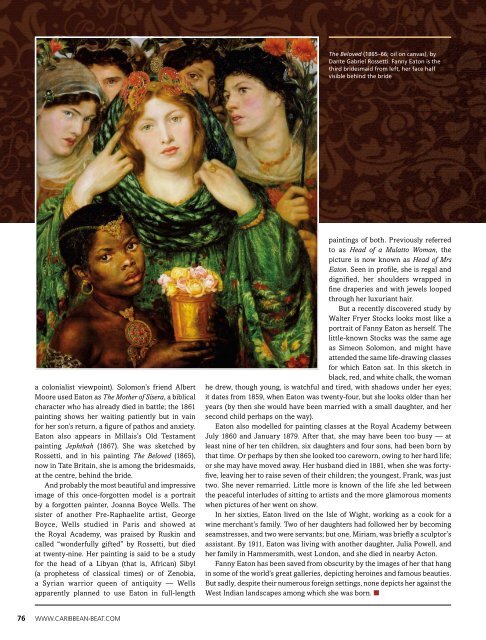Caribbean Beat — January/February 2017 (#143)
A calendar of events; music, film, and book reviews; travel features; people profiles, and much more.
A calendar of events; music, film, and book reviews; travel features; people profiles, and much more.
You also want an ePaper? Increase the reach of your titles
YUMPU automatically turns print PDFs into web optimized ePapers that Google loves.
The Beloved (1865–66; oil on canvas), by<br />
Dante Gabriel Rossetti. Fanny Eaton is the<br />
third bridesmaid from left, her face half<br />
visible behind the bride<br />
a colonialist viewpoint). Solomon’s friend Albert<br />
Moore used Eaton as The Mother of Sisera, a biblical<br />
character who has already died in battle; the 1861<br />
painting shows her waiting patiently but in vain<br />
for her son’s return, a figure of pathos and anxiety.<br />
Eaton also appears in Millais’s Old Testament<br />
painting Jephthah (1867). She was sketched by<br />
Rossetti, and in his painting The Beloved (1865),<br />
now in Tate Britain, she is among the bridesmaids,<br />
at the centre, behind the bride.<br />
And probably the most beautiful and impressive<br />
image of this once-forgotten model is a portrait<br />
by a forgotten painter, Joanna Boyce Wells. The<br />
sister of another Pre-Raphaelite artist, George<br />
Boyce, Wells studied in Paris and showed at<br />
the Royal Academy, was praised by Ruskin and<br />
called “wonderfully gifted” by Rossetti, but died<br />
at twenty-nine. Her painting is said to be a study<br />
for the head of a Libyan (that is, African) Sibyl<br />
(a prophetess of classical times) or of Zenobia,<br />
a Syrian warrior queen of antiquity <strong>—</strong> Wells<br />
apparently planned to use Eaton in full-length<br />
paintings of both. Previously referred<br />
to as Head of a Mulatto Woman, the<br />
picture is now known as Head of Mrs<br />
Eaton. Seen in profile, she is regal and<br />
dignified, her shoulders wrapped in<br />
fine draperies and with jewels looped<br />
through her luxuriant hair.<br />
But a recently discovered study by<br />
Walter Fryer Stocks looks most like a<br />
portrait of Fanny Eaton as herself. The<br />
little-known Stocks was the same age<br />
as Simeon Solomon, and might have<br />
attended the same life-drawing classes<br />
for which Eaton sat. In this sketch in<br />
black, red, and white chalk, the woman<br />
he drew, though young, is watchful and tired, with shadows under her eyes;<br />
it dates from 1859, when Eaton was twenty-four, but she looks older than her<br />
years (by then she would have been married with a small daughter, and her<br />
second child perhaps on the way).<br />
Eaton also modelled for painting classes at the Royal Academy between<br />
July 1860 and <strong>January</strong> 1879. After that, she may have been too busy <strong>—</strong> at<br />
least nine of her ten children, six daughters and four sons, had been born by<br />
that time. Or perhaps by then she looked too careworn, owing to her hard life;<br />
or she may have moved away. Her husband died in 1881, when she was fortyfive,<br />
leaving her to raise seven of their children; the youngest, Frank, was just<br />
two. She never remarried. Little more is known of the life she led between<br />
the peaceful interludes of sitting to artists and the more glamorous moments<br />
when pictures of her went on show.<br />
In her sixties, Eaton lived on the Isle of Wight, working as a cook for a<br />
wine merchant’s family. Two of her daughters had followed her by becoming<br />
seamstresses, and two were servants; but one, Miriam, was briefly a sculptor’s<br />
assistant. By 1911, Eaton was living with another daughter, Julia Powell, and<br />
her family in Hammersmith, west London, and she died in nearby Acton.<br />
Fanny Eaton has been saved from obscurity by the images of her that hang<br />
in some of the world’s great galleries, depicting heroines and famous beauties.<br />
But sadly, despite their numerous foreign settings, none depicts her against the<br />
West Indian landscapes among which she was born. n<br />
76 WWW.CARIBBEAN-BEAT.COM


















